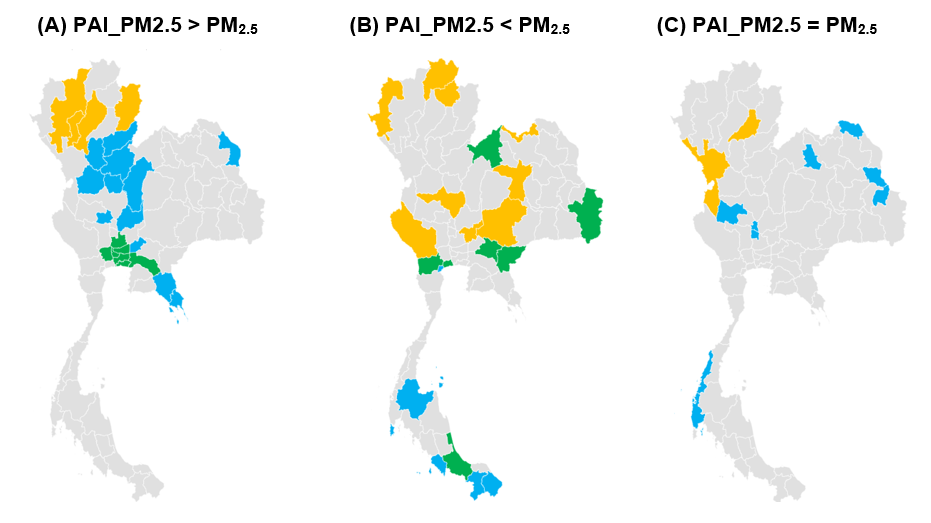Public Attention Index of Air Pollution Exposure from PM2.5 in Thailand
Main Article Content
Abstract
Thailand faces a persistent PM2.5 challenge, with pollution levels consistently exceeding the World Health Organization’s guidelines. In response, the Thai government has made air pollution a national priority, implementing various policies and city-level plans to reduce exposure. These policies are often temporary and do not fully address root causes, whereas the limited monitoring coverage across Thailand restricts a comprehensive assessment of PM2.5 exposure severity. This study addresses the data gap by constructing a public attention index for PM2.5, using internet search data from Google Trends, to quantify public awareness and concern regarding PM2.5 exposure. This index aims to improve the understanding of PM2.5 exposure across Thailand and support more effective air quality management strategies. The findings indicate a statistically significant positive relationship between public attention, PM2.5 pollution levels, willingness to pay for PM2.5 reduction, and economic and social costs associated with PM2.5. The PAI_PM2.5 index serves as a valuable tool for policymakers, offering a data-driven method to align public perceptions with the true severity of pollution issues. The results further indicate that public attention is notably high in severely impacted areas, particularly Bangkok and the northern provinces, yet reveal an awareness gap in regions with significant pollution but low public concern. These findings have important policy implications, highlighting the need for targeted public awareness campaigns and specialized initiatives to improve air quality.
Article Details

This work is licensed under a Creative Commons Attribution-NonCommercial 4.0 International License.
Published articles are under the copyright of the Applied Environmental Research effective when the article is accepted for publication thus granting Applied Environmental Research all rights for the work so that both parties may be protected from the consequences of unauthorized use. Partially or totally publication of an article elsewhere is possible only after the consent from the editors.
References
Kasikorn Research Center. PM2.5 crisis could get much worse if it is not quickly dealt with [Internet]. Kasikorn Bank; 2023 [cited 2023 Sep 24]. Available from: https://www.kasikornresearch.com/en/analysis/k-econ/business/Pages/PM25-Pollution-CIS3401-10-04-2023.aspx
Misra P, Takeuchi W. Assessing population sensitivity to urban air pollution using google trends and remote sensing datasets. The International Archives of Photogrammetry, Remote Sensing and Spatial Information Sciences. 2020;42: 93-100.
Chulalongkorn University. Stay safe in the PM2.5. 1st ed. Chulalongkorn University; 2021.
Attavanich W. Knowledge about the Impact of Air Pollution on the Thai Economy and Society. CCAS; 2022.
World Health Organization. The cost of clean air in Thailand [Internet]. WHO; 2022 [cited 2023 Sep 24]. Available from: https://www.who.int/thailand/news/detail/08-06-2022-the-cost-of-clean-air-in-thailand
Ministry of Public Health. HDC–Report: Illness due to diseases from air pollution [Internet]. Ministry of Public Health [cited 2023 Sep 20]. Available from: https://hdcservice.moph.go.th/hdc/reports/page.php?cat_id=f16421e617aed29602f9f09d951cce68.
Air quality and noise management bureau. Air quality situation. Pollution control department of Thailand. Situation and management of air and noise pollution problems of Thailand in 2018. 2020; 28-35.
Ryu YH, Min SK. What matters in public perception and awareness of air quality? Quantitative assessment using internet search volume data. Environmental Research Letters. 2020;15(9):0940b0944.
Tuhkuri J. Big data: Do google searches predict unemployment. Helsingin yliopisto, https://helda. helsinki. fi/handle/10138/155258 (viitattu 11.9. 2017). 2015 May.
Liu Y, Peng G, Hu L, Dong J, Zhang Q. Using Google trends and Baidu index to analyze the impacts of disaster events on company stock prices. Ind Manag Data Syst. 2020;120(2):350-65.
Nazar W, Plata-Nazar K. Changes in Air Pollution-Related Behavior Measured by Google Trends Search Volume Index in Response to Reported Air Quality in Poland. Int J Environ Res Public Health. 2021;18(21):11709.
Xu G, Feng X, Li Y, Jia J. Mediation effects of online public attention on the relationship between air pollution and precautionary behavior. J Manag Sci Eng. 2022;7(1):159-72.
Pollution Control Department. Standard Operating Procedure for Northern Haze Response. Ministry of Natural Resource and Environment; 2021.
Jiang W, Wang Y, Tsou MH, Fu X. Using social media to detect outdoor air pollution and monitor air quality index (AQI): A geo-targeted spatiotemporal analysis framework with Sina Weibo (Chinese Twitter). PLoS ONE. 2015;10(10).
Yang X, Dong X, Jiang Q, Liu G. Factors influencing public concern about environmental protection: an analysis from China. Discrete Dyn Nat Soc. 2019;2019.
Newig, J, Hesselmann, J. Modelling the Dynamics of Public Attention towards Environmental Issues. Complexity and Integrated Resources Management, 159.
